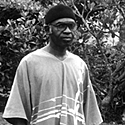
photograph by Simon Ottenberg

|
Obiora Udechukwu
More than any other artist, Obiora Udechukwu has assumed the mantle of leadership after Uche Okeke, developing and expanding Nsukka aesthetic horizons and becoming an influential art teacher. Born in Onitsha in 1946, where he grew up, his parental home is in nearby Agulu. He studied for a year at Ahmadu Bello University before he served in the Biafran War. Udechukwu completed his bachelor's and master's of fine arts degrees in 1972 and 1977, respectively, at the University of Nigeria, Nsukka.
During the Biafran War (1967-70) Udechukwu created somber pictures of suffering and death.
Afterwards he used uli extensively, interlacing specific motifs with explorations of general linear style. Unlike many of the artists represented here, he experiments with a great variety of media and print techniques, and his works reflect a broad spectrum of subject matter.
Udechukwu frequently depicts ordinary workers and the downtrodden: dock hands, women waiting patiently in line at a water tap, starving and thirsty beggars. Since the war he has pushed social issues to the forefront by producing compelling scenes of the misfortunes that befall ordinary Nigerians. At the same time he was creating numerous works that celebrate the weather and lovely hills of Nsukka.
In the late 1970s Udechukwu began to incorporate nsibidi into his art. This design system originated east of the Igbo with the Ejagham, but it later spread to the southeast of Igboland. A system of motifs associated with male secret societies called Ekpe, which survive to this day, nsibidi can be used to send messages. Its symbols often stand for social relationships--love, marriage, divorce--or powerful emotions, such as aggression or hate. The mirror is a favorite nsibidi motif employed by Udechukwu, for the mirror reflects appearances truthfully.
In recent years Udechukwu's symbolically complex art has become more abstract and philosophical. He has turned to using acrylic to create his rich designs and details. Surfaces are enlivened with sgraffito, a scratch technique in which a fork, comb, or knife is pulled through wet acrylic to produce crosscutting designs and uli and nsibidi motifs. Ultimately his art attests to his continual experimentation and development, and his movement towards the international art scene.
|








